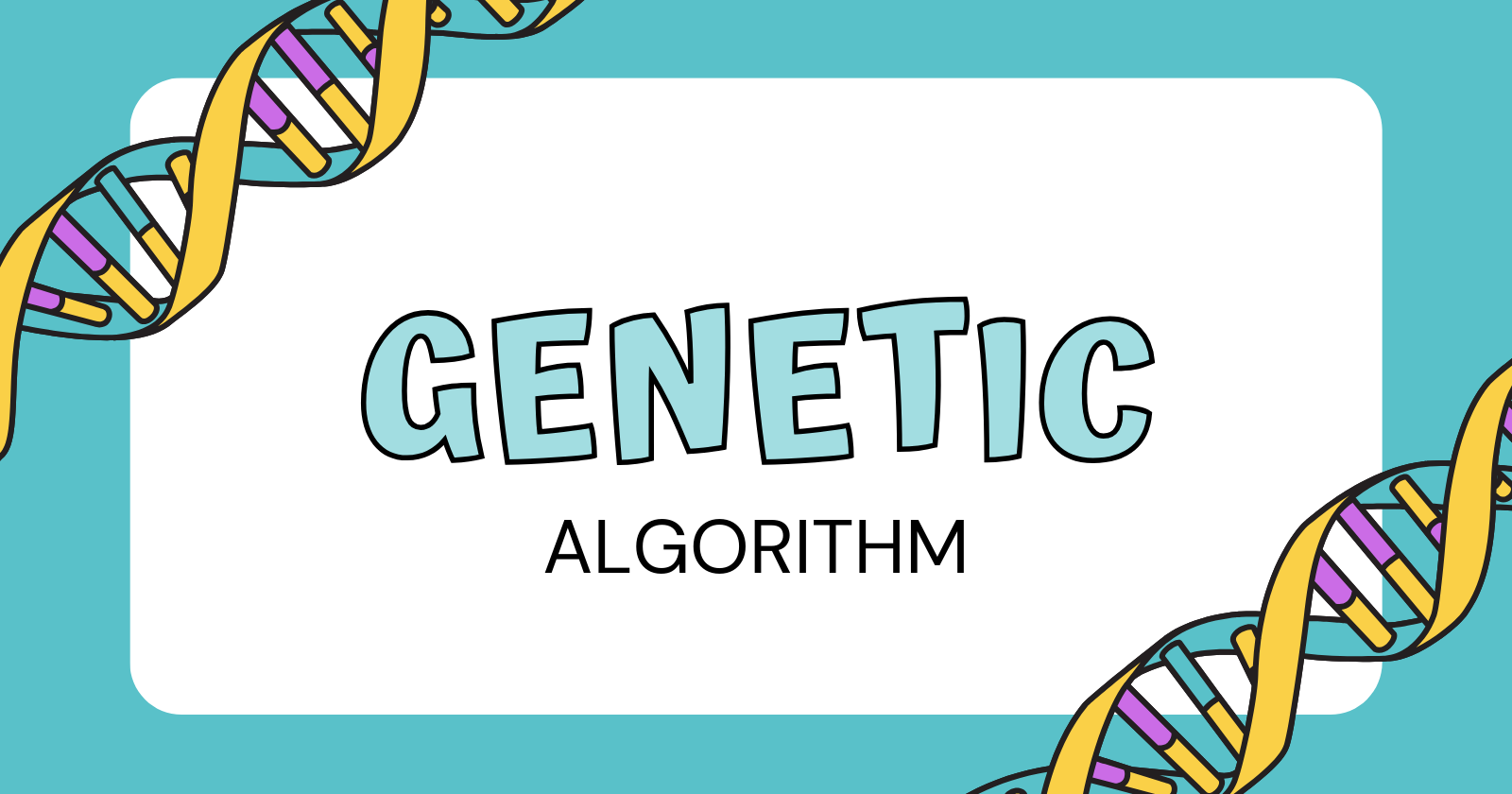Genetic Algorithm in Machine Learning
 Aayushman Sharma
Aayushman Sharma
Genetic Algorithms (GAs) represent adaptive heuristic search algorithms rooted in the principles of natural selection and genetics. They intelligently leverage random search, guided by historical data, to navigate towards improved solutions within the solution space. Widely employed for generating high-quality solutions to optimization and search problems, GAs are renowned for their effectiveness and versatility in various domains.
What is Genetic Algorithm?
Genetic algorithms draw inspiration from Charles Darwin's theory of natural selection and genetics, applying these concepts to optimization and search problems.
GA operate on a population of potential solutions (chromosomes) to the optimization problem, evolving the population over successive generations.
Genetic algorithms find applications in various fields, including engineering, finance, scheduling, and artificial intelligence, where traditional optimization methods may struggle due to complex, nonlinear, or multi-modal objective functions.
How Genetic Algorithm Work
Initialization: Creating an initial population of potential solutions.
Fitness Function: Evaluating the quality of each solution based on its ability to solve the problem.
Selection: Choosing individuals from the population to become parents for the next generation.
Crossover (Recombination): Combining genetic material from two parents to create offspring.
Mutation: Introducing random changes to individual chromosomes to maintain diversity.
Replacement: Replacing the old generation with new offspring based on fitness.
Termination: Determining when to stop the evolution process, often based on reaching a maximum number of generations or satisfactory fitness level.
Example :
Let's take an example to illustrate how Genetic Algorithms can be used to solve Sudoku puzzles. Sudoku is a classic combinatorial puzzle where the objective is to fill a 9x9 grid with digits from 1 to 9, such that each row, column, and 3x3 subgrid contains all the digits exactly once. We'll utilize the principles of selection, crossover, and mutation to evolve solutions that satisfy the Sudoku constraints.
import numpy as np
import random
Fitness Function
def fitness_function(solution):
score = 0
for i in range(9):
score += len(set(solution[i, :])) + len(set(solution[:, i]))
for i in range(0, 9, 3):
for j in range(0, 9, 3):
score += len(set(solution[i:i+3, j:j+3].flatten()))
return score
Creating Population
def create_population(population_size):
population = []
for _ in range(population_size):
sudoku_grid = np.zeros((9, 9), dtype=int)
for i in range(9):
sudoku_grid[i] = random.sample(range(1, 10), 9)
population.append(sudoku_grid)
return population
Selection
def selection(population, tournament_size):
selected_parents = []
for _ in range(len(population)):
tournament_indices = random.sample(range(len(population)), tournament_size)
tournament_fitness_values = [fitness_function(population[i]) for i in tournament_indices]
winner_index = tournament_indices[np.argmax(tournament_fitness_values)]
selected_parents.append(population[winner_index])
return selected_parents
Crossover
def crossover(parents):
offspring = []
for i in range(0, len(parents), 2):
parent1, parent2 = parents[i], parents[i+1]
crossover_point = random.randint(1, 8)
child1 = np.vstack((parent1[:crossover_point], parent2[crossover_point:]))
child2 = np.vstack((parent2[:crossover_point], parent1[crossover_point:]))
offspring.extend([child1, child2])
return offspring
Mutation
def mutation(offspring, mutation_rate):
mutated_offspring = []
for grid in offspring:
if random.random() < mutation_rate:
i, j = random.randint(0, 8), random.randint(0, 8)
new_value = random.randint(1, 9)
grid[i, j] = new_value
mutated_offspring.append(grid)
return mutated_offspring
Genetic Algorithm
def genetic_algorithm(population_size, generations, tournament_size, mutation_rate):
population = create_population(population_size)
for _ in range(generations):
parents = selection(population, tournament_size)
offspring = crossover(parents)
offspring = mutation(offspring, mutation_rate)
population = offspring
best_solution = max(population, key=fitness_function)
return best_solution
# Parameters
population_size = 100
generations = 50
tournament_size = 5
mutation_rate = 0.01
# Run Genetic Algorithm
best_solution = genetic_algorithm(population_size, generations, tournament_size, mutation_rate)
# Display Result
print("Best Solution (Sudoku Grid):")
print(best_solution)
print("Fitness Value:", fitness_function(best_solution))
Result
Best Solution (Sudoku Grid):
[[4 7 2 1 8 6 3 5 9]
[1 8 9 3 5 6 2 4 7]
[5 3 6 9 7 2 7 8 1]
[2 8 3 5 1 9 6 7 4]
[8 7 6 5 4 3 1 9 2]
[3 4 5 6 9 1 2 7 8]
[3 9 1 7 2 5 4 8 6]
[9 6 7 8 4 2 5 3 1]
[5 4 8 1 6 3 7 2 9]]
Fitness Value: 21
Applications in Machine Learning
Feature Selection: Genetic Algorithms aid in selecting the most relevant features from a large feature space, improving model efficiency and performance.
Parameter Optimization: GAs optimize the hyperparameters of machine learning algorithms, such as learning rates and regularization parameters, to enhance model performance.
Neural Network Architecture Search: GAs help in exploring and evolving optimal neural network architectures for specific tasks, leading to more efficient and effective models.
Clustering and Classification: Genetic Algorithms facilitate data clustering and classification by optimizing clustering parameters or evolving classification rules.
Reinforcement Learning: GAs are used in evolving strategies and policies for reinforcement learning agents to maximize rewards in complex environments.
Why use Genetic Algorithms
Genetic Algorithm is Robust.
Unlike traditional optimization methods, GAs are well-suited for finding global optima in multi-modal and non-linear objective functions.
It is resilient to noise or uncertainty in the objective function, maintaining robustness even in the presence of noisy data or imperfect evaluations.
Genetic Algorithms excel in solving combinatorial optimization problems, where the search space is discrete and complex.
Conclusion
In the dynamic landscape of computer science and machine learning, Genetic Algorithms stand as a testament to the enduring power of evolutionary principles. As machine learning continues to advance, the synergy between GAs and other learning techniques promises to unlock new frontiers in artificial intelligence and optimization. By harnessing the evolutionary forces of nature, Genetic Algorithms pave the way for innovative solutions and transformative breakthroughs in the field of machine learning.
I hope you’ve enjoyed reading this post.
Note
Thank you for reading this blog post. I hope you found it informative and useful.
To sponsor my work, please visit: Sponsor Page and explore the various sponsorship options.
Subscribe to my newsletter
Read articles from Aayushman Sharma directly inside your inbox. Subscribe to the newsletter, and don't miss out.
Written by

Aayushman Sharma
Aayushman Sharma
Hello! I am Aayushman Sharma, a AI Engineer. I am interested in the field of Data Analytics, Machine Learning and AI.